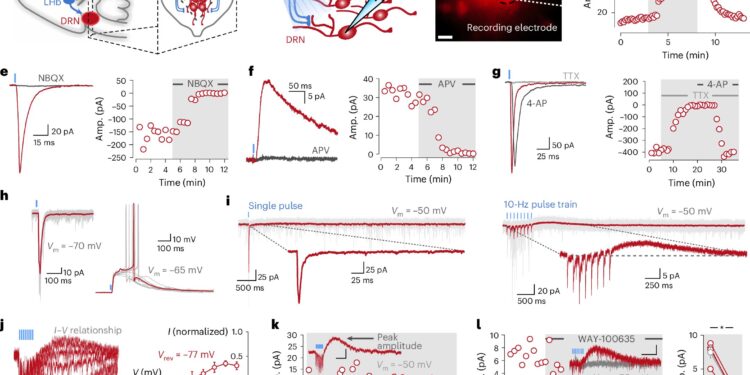Habenula The entrance to Raphe triggers direct excitation and heterosynaptic inhibition in 5-HT neurons. Credit: Nature neuroscience (2025). DOI: 10.1038 / S41593-025-01912-7
Our lives are filled with binary decisions – the choices between one of the two alternatives. But what does it really happen inside our brain when we engage in this kind of decision-making?
A study led by the Faculty of Medicine of the University of Ottawa published in Nature neuroscience Throws up a new light on these major questions, illuminating a general principle of neuronal treatment in a mysterious region of the average brain which is the very origin of our central serotonin system (5-HT), a key element of the nervous system involved in a remarkable range of cognitive and behavioral functions.
“The current dominant model is that the 5-HT individual neurons act independently of each other. Although it has already been suggested that 5-HT neurons can rather be connected to each other, it had not been directly demonstrated. Cellular and molecular medicine and co-director of the Center of Neuronal Dynamics and Artificial Intelligence of the Institute of Brain and Uottawa.
The work of the international research team involved a mixture of several experimental approaches such as electrophysiology, cell imagery, optogenetics and behavioral approaches, as well as mathematical modeling and computer simulations.
Make progress
So, what does this mean that the serotonin neurons grouped together in the brainstem are not largely independent actors, but actually send axons to the rest of the brain?
“In my opinion, the main point to remember from the document is that the serotonin system of mammals is much more complex anatomically and functionally than what we have imagined before. This is a knowledge that could potentially help develop the targeted therapy for mood disorders as major depressive disorder,” said Dr. Michael Lynn, the first author of Dr. Medicine Lab.
Dr. Lynn received his doctorate. in neuroscience from the University of Ottawa in October 2023. He is now working as a postdoctoral scholarship holder at the University of Oxford, in the department of physiology, anatomy and genetics.
He says that the results of the team are important because it turns out that there are distinct groups of serotonin neurons with their own activity models, each controlling the liberation of serotonin in a particular region of the brain. This has implications for the principle of “winning-take-all” neurosciences-an idea applied in models for calculating neural networks in which neurons are essentially taking place to.
The entry of side vessels does not recruit strong disabled inhibition on 5-HT neurons located in the Ventromedial part of DRN. Credit: Nature neuroscience (2025). DOI: 10.1038 / S41593-025-01912-7
“The new principles discovered in this article suggest that these distinct sets can interact in certain scenarios: sets of serotonin ‘` winners” with high activity can greatly reduce the release of serotonin from the “loss” of serotonin sets with lower activity levels, “he said.
“These imply a more complex and dynamic set of rules on the way and the moment of serotonin throughout the brain, contrasting with an older vision of a more monolithic signal.”
Decisions, Decisions
The work of the research team has implications on how our brain – an organ with a deeply complex wiring of neurons with multitudes of tangled connections – is involved in daily decision -making.
They determined how the lateral home, a region which is activated when we are frustrated and which is involved in major depression, ultimately controls the activity of serotonin neurons. It is also believed that habénular neurons code the threat level which is perceived from a particular environment, or perhaps even our actions.
Dr. Béique explains it as this: “Do we jump from high diving to the swimming pool? Or only bass? Do we go down this very dark alley, or do we avoid? When is it too dark?
“We believe that we have identified a circuit that participates in this very calculation that guides our daily decisions,” he said.
Following steps
What is the next step for the research team when it is based on the progress they have forged over several years with this methodical and innovative examination of the serotonin system? They aim to focus on behavioral studies with mouse models.
“At this stage, the behavioral manifestations of the calculation we have discovered were somewhat artificial behavior. We are currently trying to see if we can see similar things when the mice behave in more naturalistic environments,” explains Dr. Béïque.
More information:
Michael B. Lynn et al, non -linear recurring inhibition by facilitating the release of serotonin in raphe, Nature neuroscience (2025). DOI: 10.1038 / S41593-025-01912-7
Supplied by the University of Ottawa
Quote: The hidden complexity of the serotonin system can reshape the understanding of daily decision -making (2025, April 25) recovered on April 26, 2025 from
This document is subject to copyright. In addition to any fair program for private or research purposes, no part can be reproduced without written authorization. The content is provided only for information purposes.



